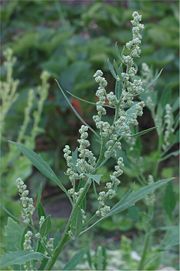Caryophyllales
| Caryophyllales | ||||||||||
|---|---|---|---|---|---|---|---|---|---|---|
Dianthus caryophyllus
|
||||||||||
| Scientific classification | ||||||||||
|
||||||||||
| Suborders | ||||||||||
|
Caryophyllineae |
||||||||||
| Synonyms | ||||||||||
|
Centrospermae |
Caryophyllales is an order of flowering plants that includes the cacti, carnations, amaranths, ice plants, and most carnivorous plants. Many members are succulent, having fleshy stems or leaves.
Contents |
Description
The Caryophyllales includes about 6% of dicot species.[1] This order is considered a core eudicot, which is also referred to as the core tricolpates. [2] Currently, the Caryophyllales contains 33 families, 692 genera and 11,155 species. [3] The monophyly of the Caryophyllales has been supported by DNA sequences, cytochrome c sequence data and heritable characters such as anther wall development and vessel-elements with simple perforations. [4]
Circumscription
As with all taxa, the circumscription of the Caryophyllales has changed within various classification systems. All systems recognize a core of families with centrospermous ovules and seeds. More recent treatments have expanded the Caryophyllales to include most carnivorous plants.
Although the monophyly of the order has been strongly supported, their placement is still uncertain. Systematists are undecided on whether Caryophyllales should be placed within the rosid complex or sister to the asterid clade. [4] Caryophyllales is separated into 2 sub-orders: Caryophyllineae and Polygonineae. [4] These two sub-orders were formerly (and sometimes still are) recognized as two orders, the Polygonales and Caryophyllales. [4]
APG II
As circumscribed by the APG II system (2003), this order includes well-known plants like cacti, carnations, spinach, beet, rhubarb, sundews, venus fly traps, and bougainvillea. Recent molecular and biochemical evidence has resolved additional well-supported clades within the Caryophyllales.
- order Caryophyllales
-
- family Achatocarpaceae
- family Aizoaceae
- family Amaranthaceae
- family Ancistrocladaceae
- family Asteropeiaceae
- family Barbeuiaceae
- family Basellaceae
- family Cactaceae
- family Caryophyllaceae
- family Didiereaceae
- family Dioncophyllaceae
- family Droseraceae
- family Drosophyllaceae
- family Frankeniaceae
- family Gisekiaceae
- family Halophytaceae
- family Molluginaceae
- family Nepenthaceae
- family Nyctaginaceae
- family Physenaceae
- family Phytolaccaceae
- family Plumbaginaceae
- family Polygonaceae
- family Portulacaceae
- family Rhabdodendraceae
- family Sarcobataceae
- family Simmondsiaceae
- family Stegnospermataceae
- family Tamaricaceae
APG

This represents a slight change from the APG system, of 1998
- order Caryophyllales
- family Achatocarpaceae
- family Aizoaceae
- family Amaranthaceae
- family Ancistrocladaceae
- family Asteropeiaceae
- family Basellaceae
- family Cactaceae
- family Caryophyllaceae
- family Didiereaceae
- family Dioncophyllaceae
- family Droseraceae
- family Drosophyllaceae
- family Frankeniaceae
- family Molluginaceae
- family Nepenthaceae
- family Nyctaginaceae
- family Physenaceae
- family Phytolaccaceae
- family Plumbaginaceae
- family Polygonaceae
- family Portulacaceae
- family Rhabdodendraceae
- family Sarcobataceae
- family Simmondsiaceae
- family Stegnospermataceae
- family Tamaricaceae
Cronquist

The Cronquist system (1981) also recognised the order, with this circumscription:
- order Caryophyllales
- family Achatocarpaceae
- family Aizoaceae
- family Amaranthaceae
- family Basellaceae
- family Cactaceae
- family Caryophyllaceae
- family Chenopodiaceae
- family Didiereaceae
- family Nyctaginaceae
- family Phytolaccaceae
- family Portulacaceae
- family Molluginaceae
The difference with the order as recognized by APG lies in the first place in the concept of "order". The APG favours much larger orders and families, and the order Caryophyllales sensu APG should rather be compared to subclass Caryophyllidae sensu Cronquist.
A part of the difference lies with what families are recognized. The plants in the Stegnospermataceae and Barbeuiaceae were included in Cronquist's Phytolaccaceae. The Chenopodiaceae (still recognized by Cronquist) are included in Amaranthaceae by APG.
New to the order (sensu APG) are the Asteropeiaceae and Physenaceae, each containing a single genus, and two genera from Cronquist's order Nepenthales.
Earlier circumscriptions
Earlier systems, such as the Wettstein system, last edition in 1935, and the Engler system, updated in 1964, had a similar order under the name Centrospermae.
References
- ↑ Caryophyllales
- ↑ Judd. W., Campbell, C., Kellog, E., Stevens, P. & M. Donoghue. (2008). Plant Systematics: A Phylogenetic Approach, Third Edition. Sinauer Associates, Inc. Sunderland, MA
- ↑ Stephens, P.F. (2001). Angiosperm Phylogeny Website. Version 8, June 2007.http://www.mobot.org/MOBOT/Research/APweb/
- ↑ 4.0 4.1 4.2 4.3 Juan et al (2007). Electrophoretic characterization of Amaranthus L. seed proteins and its systematic implication. Botanical Journal of the Linnean Society 155: 57-63.